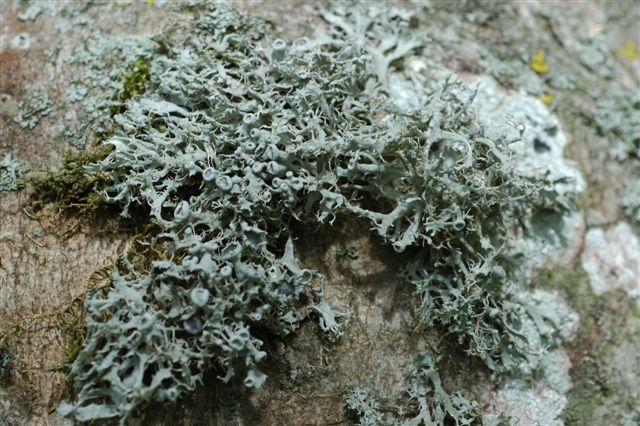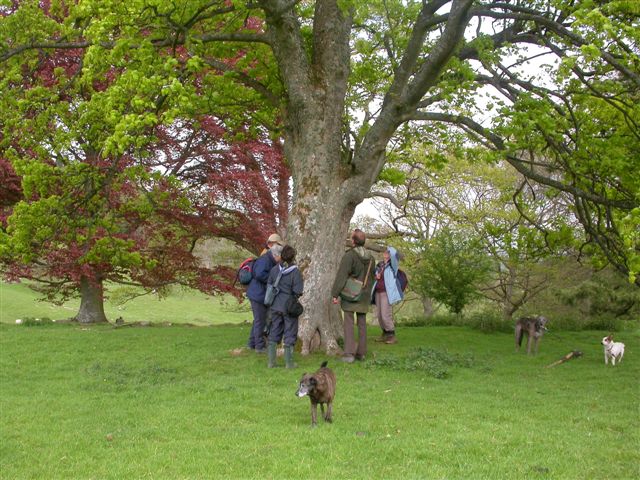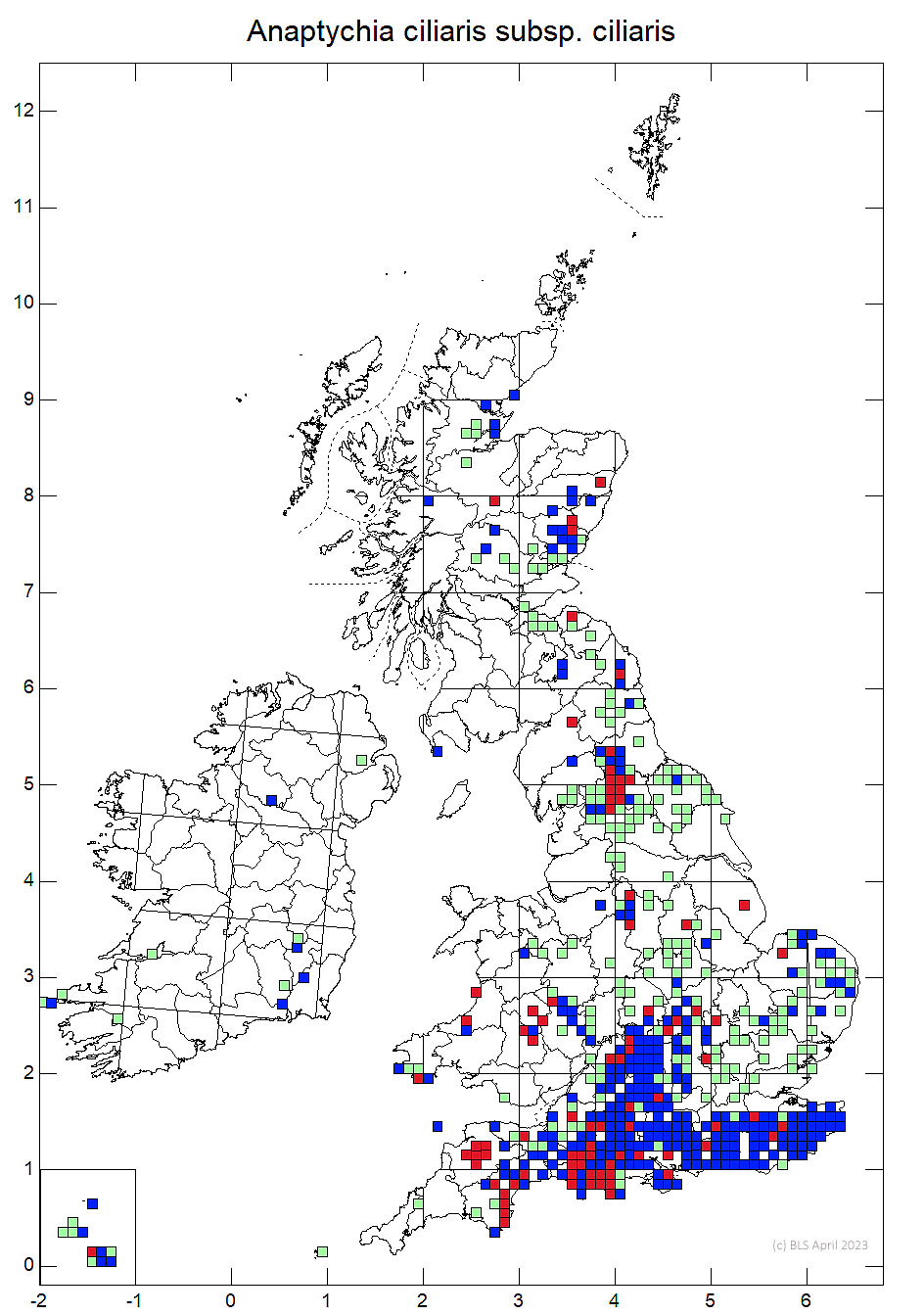This species has a grey thallus of long, narrow lobes which widen and become brown at their tips. The upper surface has a "furry" appearance whilst the lower is white and lacks a lower cortex (the hyphaea form a loose mat). Cilia line the margins of the lobes and these may be the same colour as the thallus, or darker. Apothecia are common in unpolluted areas, with black, frequently pruinose discs and borne on short stalks. They are about 5 mm in diameter with margins that become crenulate. Chemical Reactions: All negative.

Photo: Liz Fleming-Williams
Well-lit, nutrient-rich wayside trees, more rarely on mossy calcareous rocks, tombstones and walls.

Sycamore at Stanage Park bearing A. ciliaris ssp. ciliaris (Photo: Ray Woods)
Scandinavia, S & E Europe, N Africa, Canary Islands. Southern and Eastern England, with outliers in SW England, SW Ireland and SW and E Wales.
Some older and poorly-localised records have been ommitted.
| Location | Grid Reference | Last Rec'd | Recorder | SSSI |
| Brecknock: near Brechfa Pool (now lost from this tree) | SO119379 | 2003 | R.G. Woods | No |
| Ceredigion: Parc Pont-faen (Parc Neuadd)(not recently refound) | SN495594 | 1975 | R.G. Woods | Yes |
| Pembroke: Stackpole (Castle Dock Wood) | SR974967 | 1997 | A.M. Coppins & B.J. Coppins | No |
| Pembroke: Stackpole (Castle Dock Wood) | SR9742496715 | 2011 | R.G. Woods & T. Wilkins | No |
| Pembroke: Stackpole (NE of 8-Arch Bridge)(not recently refound) | SR9795 | 1987 | P.W. Wolseley & F. Dobson | Yes |
| Radnor: Maesyronnen (tree now felled) | SO179410 | 1977 | R.G. Woods | No |
| Radnor: Old Radnor | SO250591 | 2011 | R.G. Woods | No |
| Radnor: Near Burlingjobb | SO256583 | 2010 | R.G. Woods | No |
| Radnor: Stanage Park | SO334717 | 2011 | R.G. Woods | No |
| Radnor: Tynwain Farm | SO16106894 | 2011 | R.G. Woods | No |
| Radnor: Llandeilo, Rhulen & Llanbedr Hills | SO080443 | 2011 | R.G. Woods | Yes |
| Radnor: near Glasbury (tree collapsed and lost) | SO170407 | 1996 | A. Orange | No |
The following notes are from Ray Woods:
Near Brechfa Pool Brecknock- SO119379 This population may be extinct. The ancient sycamore still persists on common land but the Anaptychia is no longer evident on the trunk. There have been no obvious land use changes in its vicinity in recent years. First found in 1982, it was still present in 1994. The site is a registered common and is grazed by sheep.
Parc Pont-faen SSSI (Parc neuadd) Cardiganshire-SN495594 Neither Ray Woods nor Steve Chambers can refind the species here (or indeed the tree Ray climbed to discover it on in1975) beside the main road close to a style or gate. The site is in private ownership.
Stackpole (NE of 8-Arch Bridge) Pembrokeshire- SR97779580 The species was found here on an ash by the side of the lake (and therefore within the SSSI) by Frank Dobson and Pat Wolsley in 1987 . Brian & Sandy Coppins tried to relocate it without success during their 1997 survey at Stackpole. They found many of the ash were almost totally engulfed by ivy and bramble was also a problem forming thickets 2m high and becoming epiphytic! The site is owned by thew National trust.
Stackpole (Castle Dock Wood) Pembrokeshire- SR974967 This record was made on land within National Trust ownership in 1997 but which is not SSSI. Sandy Coppins reports "The tree is a sycamore, and we tagged it (green plastic tag, usual NT tags) no. 03020. A particularly notable ... short, misshapen tree, a very stunted "pollard" right next to the wall. Figs. 11 & 12 of the report (the Stackpole Woodlands. Lichen Survey August 1997 by AM &BJ Coppins for the National Trust and CCW) are photographs of the tree by the wall, and the A. cil-cil. A large colony of Anaptychia ciliaris ssp. ciliaris occurs on the exposed WSW side, associated with a water-seepage zone from the crotch where a branch forks off from the trunk. The area covered by the A. cil-cil is 35 x 28 cm (width x height)...... Its presence here in such a healthy colony is very important for the site. It is obviously thriving well in this exposed, well-lit and windy situation". Lower down the trunk Lobaria pulmonaria was noted.
In August 2011 Ray Woods and Tim Wilkins of Plantlife refound this tree. The Anaptychia was still growing well though no apothecia were found. In addition to the main trunk colonies a small collection of colonies was noted towards the base of a low branch growing to the north west. Due to coalescence and fragmentation of colonies an accurate count was not possible but at least 28 seperate colonies were counted. The following 3 quadrats describe the community, noting the percentage cover of each species within the quadrat.
| Quadrat number | 1 | 2 | 3 |
| Size (squ. cm.) | 25 | 30 | 20 |
| Circumference of trunk | 87 | 87 | 54 |
| Aspect | SSW | SW | E |
| Slope (degrees from horizontal) | 95 | 100 | 120 |
| Height above ground (cm) | 164 | 186 | 122 |
| Anaptychia ciliaris | 40 | 75 | 15 |
| Pyrenula macrospora | 12 | 5 | 20 |
| Pertusaria cf hymenea | 25 | 5 | 5 |
| Parmotrema perlata | 8 | 10 | 10 |
| Xanthoria parietina | 1 | 0 | 0 |
| Hyperphyscia adglutinata | 3 | 2 | 10 |
| Lobaria pulmonaria | + | + | 0 |
| Ramalina farinacea | 0 | + | 3 |
| Punctelia reddenda | 0 | 0 | + |
| Parmelina pastillifera | 0 | 0 | 1 |
| Pertusaria albescens var. corallina | 0 | 1 | 0 |
| Bark | 8 | 10 | 35 |
No immediate obvious threats other than the accidental spreading of artificial fertilizer or slurry from the adjacent agriculturally improved field were noted to this population and despite the abundance of ivy in this wood there was no ivy associated with the tree. Since the tree has lost its upper canopy despite being on the exposed windward edge of the wood wind throw would appear to be a lesser concern than might have been the case with full canopy. The lack of apothecia, obvious conidiomata or any other specialised vegetative reproductive bodies despite the obvious vigour of these colonies does cause concern. Given that this is the only known tree in SW Wales supporting this species it is likely that mating and apothecial production can no longer occur. There are a number of apparently suitable trees nearby that lack this species. Consideration should be given to the transplantation of small thallus fragments onto nearby trees to safeguard the genotype until a better understanding of mating strains is reached.
Other Pembrokeshire records: SS09: There is a record post 1960 in this hectad on the BLS Atlas data base. The source of this record has yet to be traced. SM90: There is a pre 1960 record on the NBN database from this hectad, the source of which has not been traced.
Maesyronnen Radnorshire- SO179410 This population is no more. It was on a young ash tree in a field that was turned over to arable. The inconvenience of avoiding the tree in agricultural operations led to its swift removal. The site is in private ownership.
Old Radnor Radnorshire- SO250591 This population is fertile and growing well on a mature field maple in a boundary between two compartments of what might be an ungrazed and uncultivated village green and adjacent old quarry. Ivy in 2010 had colonised the tree and was removed. The ivy had grown over 2m in one year. By April 2011 there was no sign of the ivy regrowing.The ownership of the area has not been traced. The site has to be considered vulnerable.
Burlingjobb Radnorshire- SO 256583 In 1988 fertile Anaptychia occurred on an ancient field margin ash tree just to the south of an old railway, now road carrying quarry traffic from Dolyhir Quarries. A search in 2009 failed to refind it but the tree remains. A colony, however, with a few young apotheciacontinues to persist nearby on top of an old sawn softwood railway sleeper fence post that once was the railway boundary fence but now forms the boundary of a new road to Dolyhir Quarries that replaced the railway. The railway closed in 1958 so the fence post is probably over 50 years old. The owner of the adjoining land and the ash tree is aware of the interest as a result of a chance encounter with the author. He was concerned that the highways department of Powys CC. were pressing for him to renew the fence. This site, probably in Powys CC ownership should be designated as a roadside nature reserve.
Stanage Park Radnorshire-SO3345471742 This population, in private ownership, occurs on a mature sycamore in the park to the east of the house. The crown of the sycamore is an unusual cultivar that expands lime-green leaves in the spring that later revert to more normal colouration. It is possibly grafted so the trunk on which the Anaptychia occurs may be of a different form of sycamore. It was first found in 1983 and was still growing well in 2007. High ammonia levels may pose a threat due to a number of intensive livestock units not far to the NE but the tree is sheltered by a number of trees immediately to the east of it and the lichen is confined to the west-facing side. In April 2011 RGW revisited the site with the permission of the owners and found the population healthy and fruiting abundantly. Most of the population was on the south west facing side of the trunk from 2m to 3.7m up with small amounts facing SSE and W. There was none present on the east facing side. Three quadrats all 30cm square and at right angles to the ground were recorded. Revisited by RGW in Feb 2012 there was now much evidence of slugs traversing the trunk and large parts of the colonies on the south-facing sides had been browsed to stumps of thallus lobes. Slug trails ascended from fruiting colonies of a Coprinus fungus at the trunk base to a major branch fork above the Anaptychia colonies. The winter had been mild and damp for long periods.
| Aspect | SW | SSW | SW |
| Height above ground | 3m | 3m | 3.5m |
| Anapychia ciliaris | 15 | 8 | 25 |
| Ramalina farinacea | 20 | 8 | 15 |
| Xanthoria parietina | 10 | 5 | 5 |
| Physcia adscendens | 40 | 20 | 20 |
| Bacidia rubella | 15 | 2 | 5 |
| Phaeophyscia orbicularis | 5 | 5 | 5 |
| Homalothecium sericeum | 5 | 8 | - |
| Lecanora dispersa agg. | 3 | 1 | 1 |
| Lecania cyrtella | 1 | 3 | - |
| Punctelia ulophylla | - | 2 | + |
| Pertusaria hymenea | - | 5 | - |
| Ochrolechia turneri | - | 10 | + |
| Lecanora chlarotera agg. | 1 | - | + |
| Melanelia glabratula | - | 5 | - |
| Bark | 5 | 20 | 25 |
Tynywain Radnorshire- SO16106894 This population consists of a number of colonies extending over half a square metre on a mature roadside ash tree near a farmyard. First found in 1988 it was still present in 2009 but not apparently growing as well as previously. The tree is very close to the edge of the road and on the edge of a farm yard. By April 2011 some recovery was apparent and in terms of total number of thalli this may be the largest Welsh population. It is, however, only very sparingly fertile with a handful of very immature apothecia present and with a little algal overgrowth apparent. The majority of the population faced SSW extending over an area approximately 180cm x 56cm with a small amount facing S and N. No colonies occured on the east side. Within a 30x30cm quadrat at c 2m up the trunk on the SSW facing side the following percentage covers were recorded:_ Anaptychia ciliaris 80, Bacidia rubella 5, Xanthoria parietina 4, Candelariella reflexa 3, Lecanora dispersa agg 3, Lecania cyrtella 2, Caloplaca sp. 2, Phaeophyscia orbicularis 1. New farming tenants were appraised of the importance of the tree and were clearly interested in conserving this important population.
Llandeilo, Rhulen & Llanbedr Hill SSSI Radnorshire- SO080443 The population is on a single ancient sycamore between two roads on the edge of a heavily grazed common. Always a concern that some H & S freak might decide to fell it and ask afterwards. This fertile population has gradually declined in recent years(first noted in 1982) having by 2010 been almost totally lost from all parts of the tree with an easterly aspect. There has been no significant land use changes noticed in the vicinity in recent years. It is puzzlingly absent from a sycamore of similar size some 50m to the west. In early spring 2010 large bark fragments had become detatched from both of these trees probably due to snow and ice. One fragment supported Anaptychia. The opportunity was taked to reaffix four fragments of this detached colony using plastic mesh to a young elm tree some 300m to the NE of the sycamore.
In Feb 2011 three of the transplants were still present on the elm but only one appeared likely to survive. All showed signs of being eaten and algae had begun colonising the thalli. On the donar sycamore despite the excessively snowy Dec and January there were no obvious losses with several small colonies still present on the west-facing side of the tree. The following 50 x 50cm quadrat was made to describe the community. Aspect NW, inclination 90 degrees. Anaptychia ciliaris 15%, Xanthoria parietina 20%, Physcia tenella/adscendens 5%, Phaeophyscia orbicularis 5%, Ramalina farinacea 2%, Diplotomma alboatrum 2%, Opegrapha sp. 1%, Ochrolechia turneri 1%, Physconia pulverulenta 1%, bark 50%.
Glasbury Radnorshire- SO170407 Alan Orange recorded this species in 1996 on an ash shaded by a sycamore near
Denbigh SJ13 There is a pre 1960 hectad record in the BLS Atlas data base from this square in Denbighshire just east of the Berwyns and also a record from SJ22 just SW of Oswestry, a small part of which hectad occurs in Wales.
In summary: Altogether a rather sorry tale for what, from a hectad distribution map, looks like a respectable population. It is worrying that despite searching all suitable looking trees I have not found a new site for over 20years and it is over a decade since Alan’s discovery at Maesllwch or Brian and Sandy's discovery at Stackpole. The Physcietum adscendentis, the community within which Anaptychia normally occurs is fairly widespread in the
| 1. | Monitor the habitat and species at all extant sites at least every 3 years. Through the provision of suitable information, encourage the survey of trees to identify new populations and bring these populations into the monitoring/management programme. |
| 2. | Ensure that owners and occupiers of sites with extant populations are aware of the importance and requirements of this lichen. |
| 3. | Expand suitable habitat in the wider countryside by promoting the planting of new wayside, hedgerow and parkland trees, selecting species with naturally base-rich bark such as field maple, ash and sycamore concentrating initially on areas close to existing populations. |
| 4. | Promote sympathetic land management of areas adjacent to existing populations (particularly through targeted agri-environment schemes) and ensure that existing colonies are not threatened by the growth of overshading vegetation or locally generated atmospheric pollutants. Make use of any additional records to better refine our understanding of the management requirements of this species. Develop transplant techniques to conserve genetic diversity should existing host sites become unsuitable. If necessary through tree surgery seek to prolong the life of the host tree for as long as possible. |
Rose, F. (1998) Anaptychia ciliaris ssp. ciliaris. Species account 45/1998 in the third fascicle of the Lichen Atlas of the British Isles. British Lichen Society, London.
- Log in to post comments

